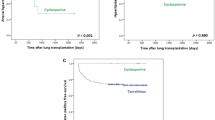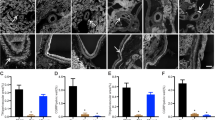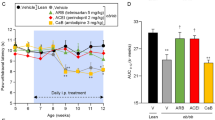Abstract
Accumulating evidence suggests an important role of the calcineurin signaling pathway in mediating the development of cardiac hypertrophy. It has also been reported that angiotensin-converting enzyme inhibitors (ACEIs) regressed cardiac hypertrophy in some animal and human models. In this study, we investigated the possible role of calcineurin in the regression of cardiac hypertrophy induced by the ACEI perindopril in rats with renovascular hypertension. The effect of the calcineurin inhibitor cyclosporine A (CsA) was also studied. Starting from 2 months after a two-kidney one-clip (2K1C) procedure, the rats that had developed progressive left ventricular (LV) hypertrophy were daily administered perindopril (1 mg/kg per day) or CsA (20 mg/kg per day) until 3 months. At the end of either treatment, the LV gravimetric, morphometric and histological measurements revealed the regression of LV hypertrophy; and the enzymatic assay, Western blotting and reverse transcription–polymerase chain reaction (RT-PCR) showed that both calcineurin activity and the calcineurin protein and mRNA expression levels were significantly decreased compared with untreated 2K1C rats, but that LV systolic performance was unchanged by either treatment. These data suggest that the cardiac hypertrophy regression induced by the ACEI perindopril is likely mediated, at least in part, through inhibition of the calcineurin signaling pathway.
Similar content being viewed by others
Article PDF
References
Brown DW, Giles WR, Croft JB : Left ventricular hypertrophy as a predictor of coronary heart disease mortality and the effect of hypertension. Am Heart J 2000; 140: 848–856.
Devereux RB, Roman MJ : Left ventricular hypertrophy in hypertension: stumuli, patterns, and consequences. Hypertens Res 1999; 22: 1–9.
Berridge MJ, Bootman MD, Lipp P : Calcium—a life and death signal. Nature 1998; 395: 645–648.
Molkentin JD, Lu JR, Antos CL, et al: A calcineurin-dependent transcriptional pathway for cardiac hypertrophy. Cell 1998; 23: 215–228.
Koulmann N, Novel-Chate V, Peinnequin A, et al: Cyclosporin A inhibits hypoxia-induced pulmonary hypertension and right ventricle hypertrophy. Am J Respir Crit Care Med 2006; 174: 699–705.
Zou Y, Yamazaki Y, Nakagawa K, et al: Continuous blockade of L-type Ca2+ channels suppresses activation of calcineurin and development of cardiac hypertrophy in spontaneously hypertensive rats. Hypertens Res 2002; 25: 117–124.
Zobel C, Rana OR, Saygili E, et al: Mechanisms of Ca2+-dependent calcineurin activation in mechanical stretch-induced hypertrophy. Cardiology 2007; 107: 281–290.
Obata K, Nagata K, Iwase M, et al: Overexpression of calmodulin induced cardiac hypertrophy by a calcineurin-dependent pathway. Biochem Biophys Res Commun 2005; 338: 1299–1305.
Shikata C, Takeda A, Takeda N : Effect of an ACE inhibitor and an AT1 receptor antagonist on cardiac hypertrophy. Mol Cell Biochem 2003; 248: 197–202.
Onodera T, Okazaki F, Miyazaki H, et al: Perindopril reverses myocyte remodeling in the hypertensive heart. Hypertens Res 2002; 25: 85–90.
Wake R, Kim-Mitsuyama S, Izumi Y, et al: Beneficial effect of candesartan on rat diastolic heart failure. J Pharmacol Sci 2005; 98: 372–379.
Hill JA, Karimi M, Kutschke W, et al: Cardiac hypertrophy is not a required compensatory response to short-term pressure overload. Circulation 2000; 101: 2863–2869.
Diedrichs H, Mei C, Frank KF, et al: Calcineurin independent development of myocardial hypertrophy in transgenic rats overexpressing the mouse rennin gene, TGR (mREN2) 27. J Mol Med 2004; 82: 688–695.
Crabtree OF, Olson EN : NFAT signaling: choreographing the social lives of cells. Cell 2002; 109 ( Suppl): S67–S79.
Ritter O, Hack S, Schuh K, et al: Calcineurin in human heart hypertrophy. Circulation 2002; 105: 2265–2269.
Burkard N, Becher J, Heindl C, et al: Targeted proteolysis sustains calcineurin activation. Circulation 2005; 111: 1045–1053.
Hallhuber M, Burkard N, Wu R, et al: Inhibition of nuclear import of calcineurin prevents myocardial hypertrophy. Circ Res 2006; 99: 626–635.
Lim HW, Windt LJ, Mante J, et al: Reversal of cardiac hypertrophy in transgenic disease models by calcineurin inhibition. J Mol Cell Cardiol 2000; 32: 697–709.
Molkentin JD, Heineke J : Regulation of cardiac hypertrophy by intracellular signaling pathways. Nat Rev Mol Cell Biol 2006; 7: 589–600.
De Windt LJ, Lim HW, Haq S, et al: Calcineurin promotes protein kinase C and c-Jun NH2-terminal kinase activation in the heart. J Biol Chem 2000; 275: 13571–13579.
Sanna B, Bueno OF, Dai YS, et al: Direct and indirect interaction between calcineruin-NFAT and MEK1-extracellular signal–regulated kinase 1/2 signaling pathways regulate cardiac gene expression and cellular growth. Mol Cell Biol 2005; 25: 865–878.
Pan F, Sun L, Kardian DB, et al: Feedback inhibition of calcineurin and Ras by a dual inhibitory protein Carabin. Nature 2007; 445: 433–436.
Izumi Y, Kim S, Zhan Y, et al: Important role of angiotensin II–mediated c-Jun NH2-terminal kinase activation in cardiac hypertrophy in hypertensive rats. Hypertension 2000; 36: 511–516.
Nagata K, Somura F, Obata K, et al: AT1 receptor blockade reduces cardiac calcineurin activity in hypertensive rat. Hypertension 2002; 40: 168–174.
Matsumoto N, Ishimitsu T, Okamura A, et al: Effects of imidapril on left ventricular mass in chronic hemodialysis patients. Hypertens Res 2006; 29: 253–260.
Yokoyama H, Averill DB, Brosnihan KB, et al: Role of blood pressure reduction in prevention of cardiac and vascular hypertrophy. Am J Hypertens 2005; 18: 922–929.
Author information
Authors and Affiliations
Corresponding author
Rights and permissions
About this article
Cite this article
Sheng, H., Zhu, J., Wu, X. et al. Angiotensin-Converting Enzyme Inhibitor Suppresses Activation of Calcineurin in Renovascular Hypertensive Rats. Hypertens Res 30, 1247–1254 (2007). https://doi.org/10.1291/hypres.30.1247
Received:
Accepted:
Issue date:
DOI: https://doi.org/10.1291/hypres.30.1247
Keywords
This article is cited by
-
17beta-estradiol attenuates pressure overload-induced myocardial hypertrophy through regulating caveolin-3 protein in ovariectomized female rats
Molecular Biology Reports (2011)
-
Inhibitory Effect of Antihypertensive Drugs on Calcineurin in Cardiomyocytes
American Journal of Hypertension (2009)



